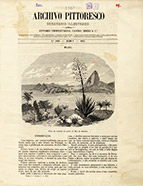

................................
In the century when AP was produced, no project assumed a more political tone than the grand national identity constructions characteristic of modernity. The prologue published in the first issue of 1860 offers an illuminating perspective on AP’s mission in Portugal. During this phase, the editors clarified their objectives: “(...) to nationalise this newspaper even further, not only with Portuguese portraits, monuments, buildings, landscapes, products, and cultural types, published through wood engravings by our own artists, but also by recounting the deeds and actions of our ancestors, their customs and traditions” ( AP , 1860, pp. 1-2). As part of this "second phase," as the editors described it, AP remained committed to moral and religious content. Additionally, AP was now formally integrated as an educational tool in schools and other institutions, transitioning from a general aim to an explicit purpose. Education now encompassed literacy initiatives for the broader population and promoted the Portuguese language.
An important point to highlight is that, through this movement, history— previously presented through lengthy monographs, pamphlet novels, ancient excerpts, and various other writings— began to adopt a more structured and formative character. In the same prologue, the editors stated that, rather than current topics, studies of the past were best suited for educating young readers. Accordingly, AP introduced sections dedicated to "national antiquities" and "mother tongue studies." Without abandoning its earlier formats, AP now featured articles on the monuments and historical buildings of Lisbon and other cities more prominently. The defence of the Portuguese language manifested, for example, in strong criticisms of French influence, which, following years of occupation and France’s key role in modernising the press, led to a series of negative reviews about “Gallicisms.” Heritage, legends, religious traditions, literature, and studies of events central to defining the national character— such as the Iberian Union and the Restoration of 1640— began to captivate the AP’s contributors. The meticulous pursuit of “ignored, vanished, or distorted” truths in archives also became a focal point of interest ( AP , 1861, p. 2). It Is important to highlight that prominent historians, including Alexandre Herculano and Camilo Castelo Branco, contributed articles to the magazine, which was led by editors deeply invested in historical scholarship, such as Inácio de Vilhena Barbosa, António da Silva Túlio, and Luís Augusto Rebello da Silva. Many of these editors and contributors were members of the Academia Real das Ciências [Royal Academy of Sciences] in Lisbon. Even those better known for their work in journalism or theatre, like António Pedro Lopes de Mendonça, often contributed historical writings. During AP’s early years, notable articles appeared, such as Curiosidades históricas: acerca dos preços em Portugal nos séculos XV e XVI [Historical Curiosities: On Prices in Portugal in the 15th and 16th Centuries] (AP, 1857, p. 342) and Filipe II e a nobreza portuguesa durante as suas pretensões ao trono de Portugal (apontamento de um livro inédito) [Philip II and the Portuguese Nobility During His Claims to the Throne of Portugal (Notes from an Unpublished Book)] (AP, 1858, pp. 50-67-98). Other significant contributions included José de Torres's reflections on the reign of Pedro II at the end of the 17th century (AP, 1858, p. 319) and, later, José Maria Latino Coelho’s article, Ciência na Idade Média e as enciclopédias desse tempo [Science in the Middle Ages and the encyclopaedias of that time] (AP, 1864, p. 143). These are just a few examples of the wide variety of cases recorded in the journal's collection.
This work is financed by national funds through FCT - Foundation for Science and Technology, I.P, in the scope of the projects UIDB/04311/2020 and UIDP/04311/2020.
